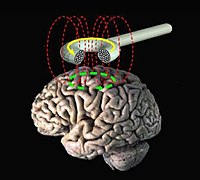
Photo from wikipedia
This current review summarizes the investigational and therapeutic applications of transcranial magnetic stimulation (TMS) in schizophrenia. Fairly consistent findings of an impaired cortical excitation-inhibition balance, cortical plasticity, and motor resonance… Click to show full abstract
This current review summarizes the investigational and therapeutic applications of transcranial magnetic stimulation (TMS) in schizophrenia. Fairly consistent findings of an impaired cortical excitation-inhibition balance, cortical plasticity, and motor resonance have been reported in schizophrenia. Cortical connectivity impairments have also been demonstrated in motor and prefrontal brain regions. In terms of treatment, the best support is for 1-Hz TMS to the left temporoparietal cortex for the short-term treatment of persistent auditory hallucinations. High-frequency TMS to the left prefrontal cortex improves negative and cognitive symptoms, but with inconsistent and small effects. TMS combined with diverse brain mapping techniques and clinical evaluation can unravel critical brain-behavior relationships relevant to schizophrenia. These provide critical support to the conceptualization of schizophrenia as a connectopathy with anomalous cortical plasticity. Adaptive modulation of these aberrant brain networks in a neuroscience-informed manner drives short-term therapeutic gains in difficult-to-treat symptoms of schizophrenia.
Journal Title: Current Psychiatry Reports
Year Published: 2019
Link to full text (if available)
Share on Social Media: Sign Up to like & get
recommendations!